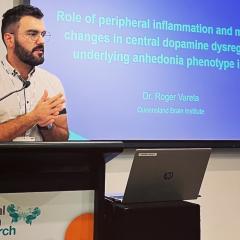Queensland Brain Institute (QBI) researchers have discovered a genetic mechanism that may explain why the children of older fathers are more likely to develop schizophrenia or autism.
Using genome-wide microarray screening technology, researchers compared the offspring of 3 month old male mice with those fathered by less sprightly 14-16 month old sires.
They found that mice fathered by older dads had an increased number of new copy number variants (CNVs) in their DNA.
While some genetic changes involve only one ‘letter’ of the genetic code, CNVs can delete or repeat whole ‘paragraphs’ of genetic code.
These results offered the first experimental demonstration that the offspring of older males have an increased risk of de novo (new) CNVs, according to QBI Professor John McGrath, who conducted the research with Professor Emma Whitelaw (Queensland Institute of Medical Research), and QBI’s Claire Foldi and Traute Flatscher-Bader.
“While we’ve known for some time that the children of older fathers are more likely to develop schizophrenia or autism, this study provides the first evidence of the biological mechanism that may be responsible,” he explains.
Compared to the offspring of fathers in their early twenties, the offspring of fathers aged 50 years or over have a two-fold increased risk of these neurodevelopmental disorders.
Schizophrenia affects about one in a hundred Australian adults, while autism affects about one in two hundred children.
Professor McGrath says the male germ line (the precursor of sperm) undergoes many more cell divisions across adulthood than the female germ line (the precursor of the oocyte).
Therefore, the increased load of genetic changes in the sperm of older fathers occurs simply because there is more room for error as time goes on.
Professor McGrath says that these findings, published in the latest issue of Translational Psychiatry, add further weight to the notion that men, too, must heed the ticking of their biological clocks.
“Because many people are delaying parenthood, it’s feasible that the incidence of paternal-age related mutations will increase over time,” he says.
McGrath says these findings now open the door to larger research projects which will explore if these age-related CNVs are more likely to affect brain-related genes.
The research has also provided important new clues to the causes of brain disorders such as autism and schizophrenia.
“Obviously, this isn’t a study we can conduct on humans, but understanding the impact of advanced paternal age on offspring health could have important implications for future public health,” he says.
MEDIA CONTACT
Email: d.cullen2@uq.edu.au
EPIDEMIOLOGY AND DEVELOPMENTAL NEUROBIOLOGY LAB
Researchers in Professor John McGrath’s laboratory explore non-genetic risk factors for disorders of brain development such as schizophrenia and autism. Using animal models, the group has forged productive cross-disciplinary collaborations linking risk factor epidemiology with developmental neurobiology. The McGrath laboratory has made several significant discoveries in recent years, including the importance of prenatal vitamin D on brain development. Professor McGrath has supervised major systematic reviews of the incidence, prevalence and mortality of schizophrenia.
QUEENSLAND BRAIN INSTITUTE
The Queensland Brain Institute (QBI) was established as a research institute of The University of Queensland in 2003. The Institute is now operating out of a $63 million state-of-the-art facility which houses 33 Principal Investigators with strong international reputations. QBI is one of the largest neuroscience institutes in the world dedicated to understanding the mechanisms underlying brain function.



